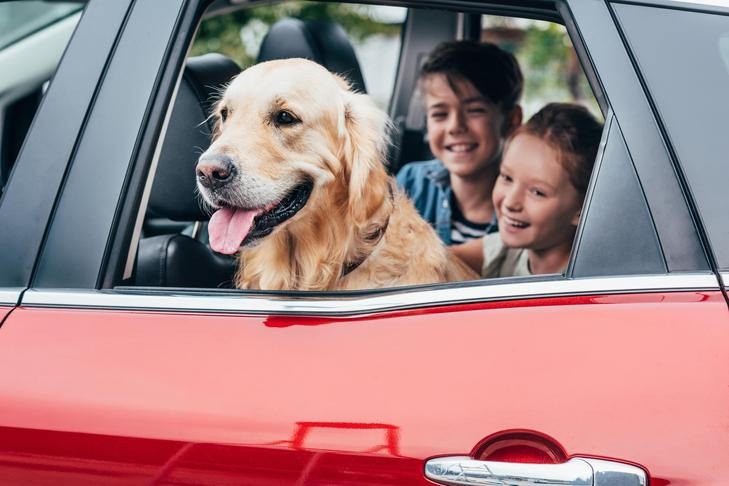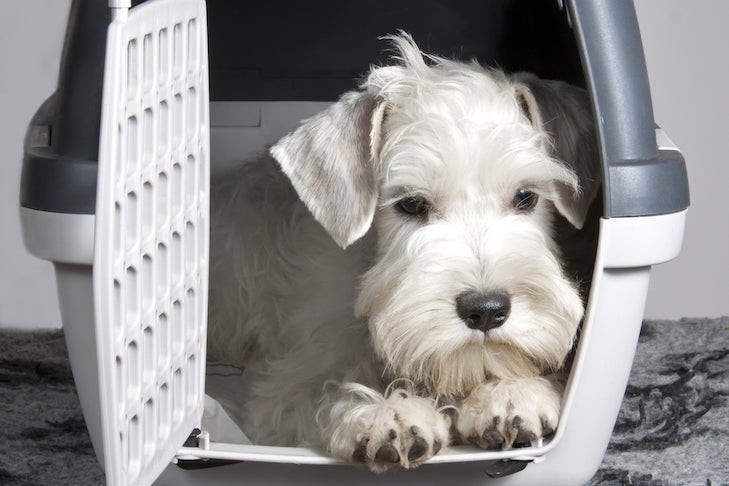Bringing your furry friend along for a road trip can be an amazing experience. However, ensuring a safe, comfortable, and enjoyable journey for both you and your dog requires careful planning and preparation. This guide covers everything you need to know about How To Travel By Car With A Dog, from pre-trip vet visits to in-car safety and comfort.
Pre-Trip Preparations: Health and Safety First
Before hitting the road, prioritize your dog’s health and safety. A visit to the veterinarian is crucial.
- Veterinary Checkup: Schedule a checkup to ensure your dog is healthy enough for travel. Confirm that all vaccinations are up-to-date. Obtain a copy of their shot records, as these may be required at certain accommodations or in case of emergencies.
- Medications and Food: Pack an adequate supply of your dog’s regular food to avoid dietary changes that could upset their stomach. Bring any necessary medications, along with a small pet first aid kit.
- Emergency Information: Program the numbers of your regular veterinarian and the nearest 24-hour veterinary emergency hospital into your phone. Having this information readily available can be life-saving in an emergency.
 Golden Retriever sitting in the backseat of a car with children.
Golden Retriever sitting in the backseat of a car with children.
Creating a Safe and Comfortable Car Environment
The key to successful car travel with your dog lies in creating a secure and comfortable environment inside your vehicle.
- Dog Crates and Carriers: For many dogs, a crate is the safest way to travel in a car. A crate prevents your dog from distracting you while driving and protects them in case of an accident. Make sure the crate is properly secured in the car.
- Dog Seat Belts and Harnesses: If your dog isn’t crated, use a dog seat belt or safety harness. These restraints attach to your car’s seat belt system and prevent your dog from moving around freely in the vehicle.
- Ventilation and Temperature: Ensure your dog has access to fresh air. Keep the car well-ventilated and monitor the temperature. Never leave your dog unattended in a closed vehicle, especially in hot weather.
- Preventing Carsickness: Some dogs experience motion sickness. To minimize this, avoid feeding your dog a large meal before traveling. Provide small amounts of water frequently. Consider consulting your veterinarian about anti-nausea medication if your dog is prone to carsickness.
Essential Items for a Dog-Friendly Road Trip
Packing the right supplies is essential for a smooth and enjoyable trip with your dog.
- Identification: Ensure your dog has proper identification, including a collar with ID tags containing your name, phone number, and address. Microchipping is also highly recommended. If you are going to a specific location for a long time, you may consider getting a temporary ID tag with the phone number and address of where you are staying.
- Leash and Waste Bags: Always keep your dog on a leash when outside the car. Bring plenty of waste bags to clean up after your dog.
- Food and Water: Pack enough of your dog’s regular food for the entire trip. Bring bottled water to avoid stomach upset from unfamiliar water sources. Pack collapsible travel bowls for easy feeding and watering on the go.
- Comfort Items: Bring your dog’s favorite toys, blankets, or bedding to make them feel more comfortable and secure.
- First-Aid Kit: A basic pet first-aid kit should include antiseptic wipes, gauze, bandages, and any medications your dog requires.
 Sealyham Terrier laying down in a travel crate.
Sealyham Terrier laying down in a travel crate.
Planning Your Route and Stops
Careful route planning can make a significant difference in your dog’s comfort and well-being during a road trip.
- Frequent Breaks: Plan to stop every two to three hours for potty breaks and exercise. Look for dog-friendly rest areas or parks along your route.
- Dog-Friendly Accommodations: Research and book dog-friendly hotels or accommodations in advance. Many hotels have size or breed restrictions, so it’s essential to confirm their pet policies before you arrive.
- Activities: Research dog-friendly activities along your route, such as hiking trails, parks, or beaches. This will give your dog a chance to stretch their legs and enjoy the trip.
Behavior and Training Tips
A well-behaved dog makes traveling much easier. Here are some tips for managing your dog’s behavior on the road.
- Acclimation to Car Travel: Gradually acclimate your dog to car travel by taking short trips before embarking on a long journey.
- Basic Obedience: Ensure your dog knows basic commands such as “sit,” “stay,” and “come.” This will help you maintain control in unfamiliar environments.
- Socialization: If your dog is not well-socialized, expose them to new people and places gradually before the trip.
- Positive Reinforcement: Use positive reinforcement techniques, such as treats and praise, to reward good behavior.
What to Do at Hotels
When staying at a dog-friendly hotel, it’s important to be a responsible pet owner.
- Respect Other Guests: Keep your dog quiet and under control at all times. Avoid leaving your dog unattended in the room, as this can lead to barking or damage.
- Designated Areas: Ask hotel management about designated dog-walking areas and always clean up after your pet.
- Protect the Property: Cover furniture with blankets or sheets to protect it from dog hair and scratches.
Traveling by car with your dog can be a wonderful experience if you plan properly. Prioritize your dog’s health and safety, create a comfortable environment, pack the essentials, and plan your route carefully. With a little preparation, you and your furry friend can enjoy a memorable road trip together.